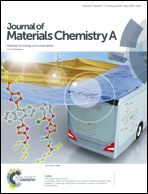Cell membrane mimetic PVDF microfiltration membrane with enhanced antifouling and separation performance for oil/water mixtures†
Abstract
The fabrication of stable and highly antifouling membranes for the separation of various oil/water mixtures remains challenging. A facile and universal coating strategy is developed to modify the chemically inert PVDF separation membrane. The membrane is first coated with a nanolayer of mussel-inspired polydopamine (PDA) from dopamine solution to provide a reactive amino surface. The universally and strongly adhered PDA mediation layer (PVDF/PDA) is then covalently anchored with a mono-layer of a cell outer membrane mimetic and reactive random copolymer (PMEN) to confer excellent antifouling nature. The PMEN coated PVDF membrane (PVDF/PDA/PMEN) demonstrates better superhydrophilicity by changing the water contact angle to 0° in 5 s and stronger underwater superoleophobicity with an oil contact angle of ∼170°. More excitingly, the sliding angle of the underwater oil droplet on the membrane is as low as 0.5°. Furthermore, the PMEN coated membrane shows great advantages over other modifications by way of enhanced separation and excellent antifouling performances for both oil-in-water emulsions and adhesive high concentration crude oil/water mixtures. This facile and universal coating strategy for the fabrication of a stable and cell-membrane-mimetic antifouling membrane has great potential in efficient oil/water separation, even in the separation of adhering crude oil/water mixtures.



 Please wait while we load your content...
Please wait while we load your content...